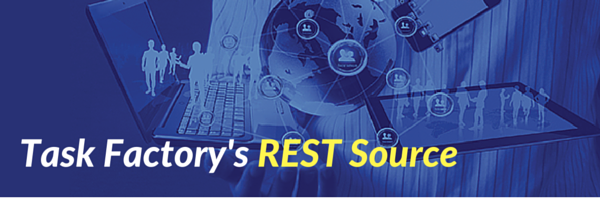
If you’re like most businesses, it’s become increasingly important to be able to get data from, or write data to, web RESTful sources. There are 1000’s of RESTful sources on the web including GoToWebinar, Salesforce.com and Google Analytics. Wouldn’t it be great to configure this with just a few simple clicks?
One of the most versatile tools in Task Factory is our REST Source and REST Destination component. There is a seemingly LIMITLESS amount of connectivity solutions, and with more and more sites and apps being launched every day, connecting to REST has never been more vital.
Do you need to connect to your QA team, Customer Support, or Operations over Slack? Use REST. Update a Trello board for the entire marketing team? Use REST. Need to grab the latest figures from your Google Analytics page or Microsoft OneDrive? Use REST!
Let’s look at a fun application for REST, using the site Yelp. Perhaps you’re looking for new consumer facing customers or maybe you just want to craft a great list of restaurants for your co-workers for a company party or maybe just for you and your family. This quick walkthrough of configuring your REST component will show you just how easy it is.
- To begin, go to yelp.com/developers to get your authentication and keys. After you have this information, configure your REST Source connection manager with your credentials.
- Next, we open the REST Source and input the URI for our API and our search parameters (for Yelp you can put in food, the city of choice and pizza for example).
- In the JSON Properties tab, we define how we want to parse the first level of JSON.
- The Headers tab is where you would put some authentication headers or whatever you would need for your API.
- Pagination Settings is how we cycle through different pages of the results that come back from our API.
- Authentication Results tab is for APIs that need to send back a token or anything more specific to that API.
- We can preview our data to see how it comes back and how we’re going to parse it from our JSON Properties tab with the Test API button.
- We can then use the Unpack Data Transform, which allows us to parse through a second level of JSON. In our case, we want to parse through our categories column.
- We chose to parse it out for an alias and title for each of the businesses that come up under food and pizza in our chosen city.
- The final step is to send it through Terminator Destination so we can do a few test runs before we send to production or to a table.
It’s that simple. With a few seconds of configuration, you can pull data from any web RESTful API source. It’s also easy to write data to nearly any RESTful connections on the web or internal services with our many pre-built configuration files.


-1.png)
Leave a comment